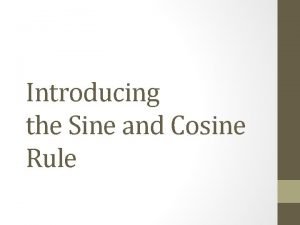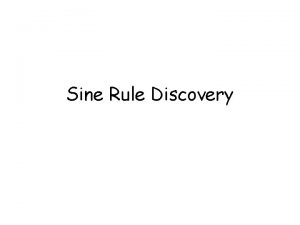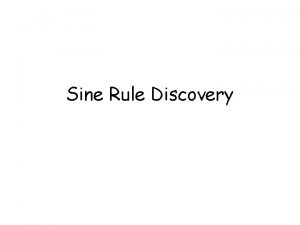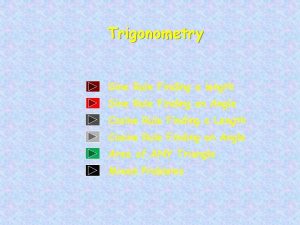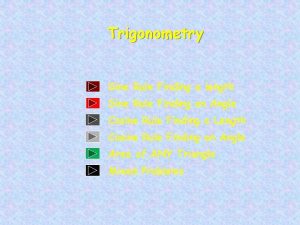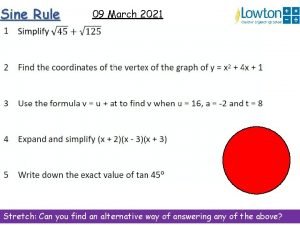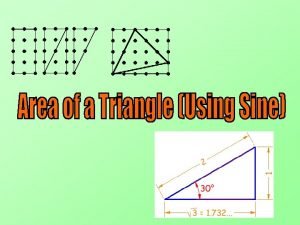The sine rule The sine rule You can









- Slides: 9

The sine rule

The sine rule You can use trigonometry to solve triangles that are not right-angled. Look at the triangle ABC. The altitude (height), h of the B triangle is BD perpendicular to AC. In the right-angled triangle ABD. c h a C This gives h = c sin A A b D In the right-angled triangle BCD. Rearranging this equation gives This gives h = a sin C Equate the values of h to give c sin A = a sin C The ratios of the sine of each angle to the length of the opposite side are equal

The sine rule You can use trigonometry to solve triangles that are not right-angled. Look at the triangle ABC. Now draw the altitude (height), h B perpendicular to AB. from C to E E In the right-angled triangle ACF. c h a C This gives h = b sin A A b In the right-angled triangle BCE. Rearranging this equation gives This gives h = a sin B Equate the values of h to give b sin A = a sin B The ratios of the sine of each angle to the length of the opposite side are equal

The sine rule is a method to calculate sides and angles of any triangle. It is useful for finding the length of one side when all the angles and one other side are known, or finding an angle when two sides and one other angle are known C For any triangle ABC: Where b A To find a side, use the sine rule written as b c a = = sin B sin C sin A or a B c To find an angle, use the sine rule written as sin A sin B sin C = = a b c

Using the sine rule to find side lengths If we are given two angles in a triangle and the length of a side opposite one of the angles, we can use the sine rule to find the length of the side opposite the other angle. For example: Find the length of side a B 39° a 118° C 7 cm A Using the sine rule: 7 a = sin 39° sin 118° 7 sin 118° a = sin 39° a = 9. 82 cm (to 3 s. f. )

Using the sine rule to find angles If we are given two side lengths in a triangle and the angle opposite one of the given sides, we can use the sine rule to find the angle opposite the other given side. For example: Find the angle at A C 14 cm A Using the sine rule: sin 98° sin A = 9. 4 14 9. 4 cm 9. 4 sin 98° sin A = 14 98° 9. 4 sin 98° – 1 B A = sin 14 B = 41. 7° (to 3 s. f. )

Using the sine rule to find angles Find the missing angles and sides in this triangle. Finding angle B Using the sine rule: sin 46° sin B = 8 6 8 sin 46° sin B = 6 8 sin 46° – 1 B = sin 6 B = 73. 6° (to 3 s. f. ) Finding angle C C = 180° – 46° - 73. 6° C = 60. 4° C 60. 4° 8 cm A 46° 6 cm 73. 6° B c 7. 25 cm Finding side c Using the sine rule: 6 c = sin 46° sin 60. 4° 6 sin 60. 4° c = sin 46° c = 7. 25 cm

Using the sine rule to find angles Find the missing angles and sides in this triangle. Finding angle B C 27. 6° Using the sine rule: sin 46° sin B = 8 cm 8 6 8 sin 46° 6 cm sin B = 6 106. 4° 46° 8 sin 46° B A B = sin– 1 c 3. 86 cm 6 Finding side c B = 73. 6° B must be obtuse Using the sine rule: B = 180 - 73. 6° = 106. 4° 6 c = Finding angle C sin 27. 6° sin 46° 6 sin 27. 6° C = 180° – 46° - 106. 4° c = sin 46° C = 27. 6° c = 3. 86 cm

Using the sine rule to find angles What do you notice in these triangles. C 27. 6° 60. 4° 8 cm A 46° C 6 cm 73. 6° B 8 cm 106. 4° 46° B c 3. 86 cm A c 7. 25 cm At the beginning they have the same values for given angles an sides, but they are two different triangles This known as the ambiguous case. When using the sine rule there can be an ambiguous case if: You are given two sides and a non-included acute angle. The side opposite the given acute angle is the shorter of the two given sides
 If you think you can you can poem
If you think you can you can poem Can sine rule be used on right angled triangles
Can sine rule be used on right angled triangles Triangle trig
Triangle trig When to use sine rule or cosine rule
When to use sine rule or cosine rule Cosine rule bbc
Cosine rule bbc If you can imagine it you can achieve it
If you can imagine it you can achieve it If you can't measure it it doesn't exist meaning
If you can't measure it it doesn't exist meaning If you can't measure it you can't manage it
If you can't measure it you can't manage it If you can't measure it you cannot improve it
If you can't measure it you cannot improve it Finanzkennzahlen
Finanzkennzahlen

